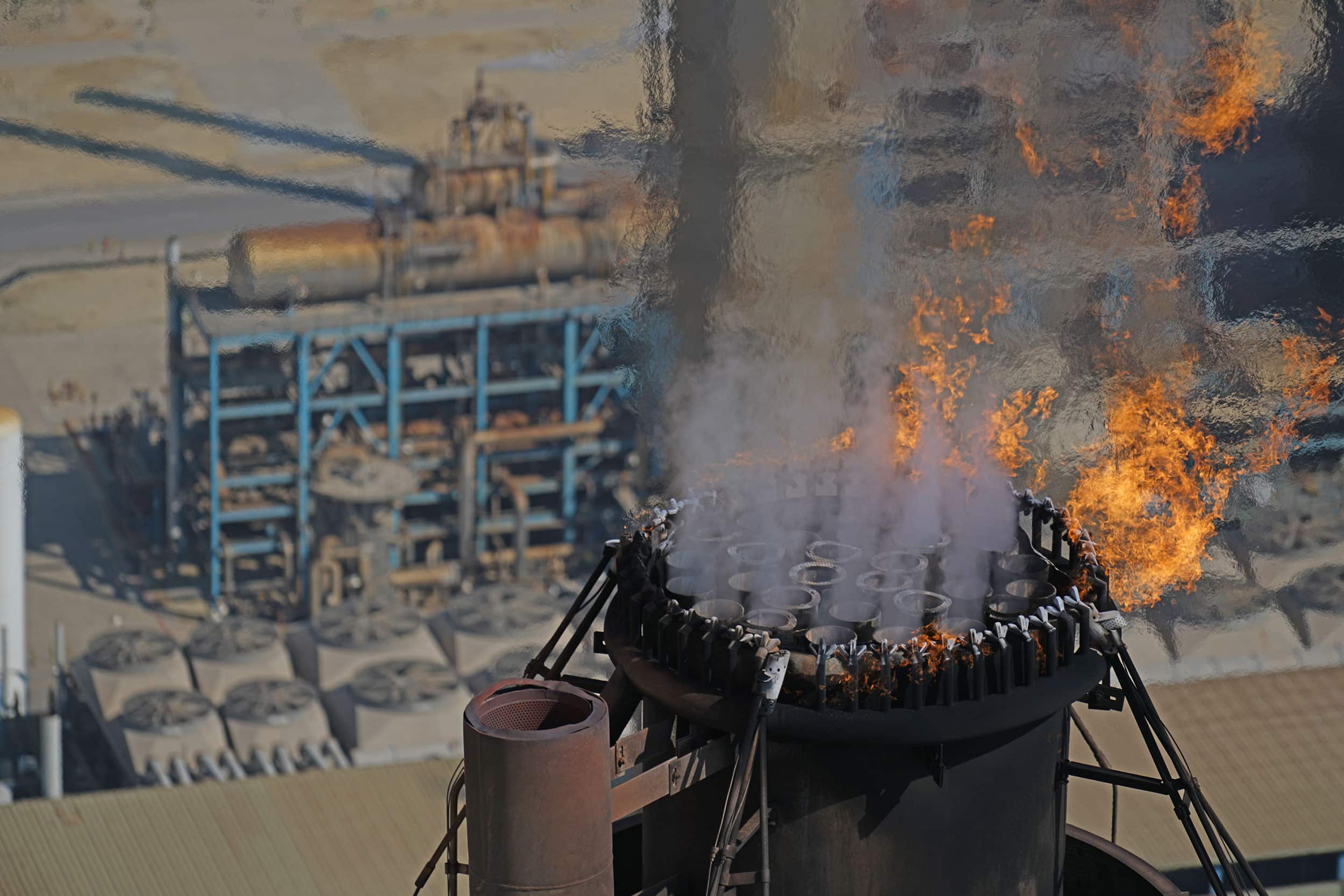
A Flare Stack is a gas combustion apparatus used at industrial sites to burn off waste or other unwanted gases. Its primary objective is to combust vent gas, which can be potentially hazardous in the event of leaking into its immediate surrounding — a large portion of which is methane — and that’s a PROBLEM. Methane is 25 times more damaging to the environment than carbon dioxide, and if is not burned properly, it will be released into the atmosphere as it is. That itself explains why Flare Stack systems are so crucial.
These systems direct the gaseous mixture to flare stacks, where it is burned to generate relatively safer ‘water vapour’ and ‘carbon dioxide’. Therefore, the Oil and Gas sector needs to ensure that your flare stacks are optimised for complete combustion efficiency. Routine flare stack inspections are the only way forward to ensure that your operations, associated people and planet are safe and sound!
Previously, inspecting a flare stack systems was a dangerous, time-intensive, labour-intensive and expensive endeavour. Document clearance, flare shut down, subsequent wait for the flare stack to cool down, security checks prior to the inspection… We haven’t even begun the flare stack examination yet. Once all these time-consuming procedures are done, that’s only when the inspection may now commence.
In the first place, inspectors have to access the Oil and Gas commonly located at remote, difficult-to-reach terrains. Then they will have to access the stack through confined spaces – using rope and even scaffolding. The exact time required for inspection varies from flare stack to stack depending on the height and size- ranging between days to weeks. Moreover, for external flare stack inspection, the danger is more in the form of high wind speed and elevation; and for the indoor inspection the inspectors have to work in highly restricted confines, and the hazardous gas leftovers cannot be entirely removed from the chamber. Well, that summarises how hazardous, time-consuming, and labor-intensive a typical internal flare stack inspection is.
Drones inspect flare stacks while they are still operational. So neither is there a need to shut down, nor are people required to work at scary heights. Simply said, the fact that the flare stacks stay active throughout inspection results in a significant cost savings.

Drones can seamlessly fly anywhere – be it the flare tip, radiation shield, pilot ignition systems, pipework, gantries and handrails, or whatever – narrow spaces or infrastructures do not limit them. Drone-powered flare stack inspection can also give a general overview of the flare stack condition, its life expectancy and significantly more. Drones enable the oil and gas industries to plan, organise, and execute maintenance operations more efficiently and effectively; enabling them to queue up maintenance during planned shutdowns thereby cutting down on unplanned shutdowns.
We have already discussed about the severity of methane gas leaks in your Oil and Gas operations. Research reveals that oil and gas operations account for over three-quarters of total methane emissions contributing to Global Warming. And therefore, the Oil and Gas Industry particularly need to make efforts to cut down all the possibilities of methane gas leaks in their operations. Similarly, this tool will also help them meet environmental guidelines set by the regulatory bodies. That being said, did you know that the all-new DJI payload – the DJI Zenmuse U10 can detect the presence of methane gas up to 100 m away in real time? U10 uses a Tunable Diode Laser Absorption Spectroscopy (TDLAS) technology to measure specific species of methane.
Here is the story of how FEDS, the only ISO-certified drone solutions provider in the region, inspected one of the tallest flare stacks in the world. The flare stack measured over 160m in height, and inspecting this flare stack in the traditional way would have been a slow, dangerous, and labour-intensive process. Even before the inspection could commence, the pre-inspection procedures would itself have taken more than a week – obtaining the necessary clearance, shutting and cooling down the stack. Once done, the actual inspection would have finally taken place, where inspectors have to scale up the 160m tall stack via rope and inspect all the assets.
The FEDS team, with their drone-powered solutions confidently turned this slow and tedious inspection into an efficient and effective process. Using their extensive fleet of DJI Drones and expertise, the FEDS team could condense a 3-5 week-long inspection operation into just one day. They chose the DJI M300 RTK paired with DJI Zenmuse H20T for this critical mission. The flare burned continuously during the examination, with no downtime. FEDS enabled the client to perform preventive maintenance during routine shutdowns, identify potential failure points, and ensure that the plant operates efficiently.
Check out our latest post here to learn more about DJI Drone solutions for the Oil and Gas business. Drone inspections in the Oil & Gas field are helping companies to cut down costs significantly – The Global market for drones in the oil and gas sector is expected to reach 16.72 billion USD by 2025. Almost all the major players in the Oil and Gas sectors have completely migrated to drone-powered solutions. For instance, BP, one of the world’s seven oil and gas “supermajors”, is one of the early adopters of drones in their operations.
Are you interested in transforming your Oil and Gas asset inspections? If you wish to add any of these powerful payloads or drones to your fleet, drop us a line at hello@thedronecentre.ae. We’d be happy to perform a demo to showcase the positive impact that drones can have on your inspection initiatives.